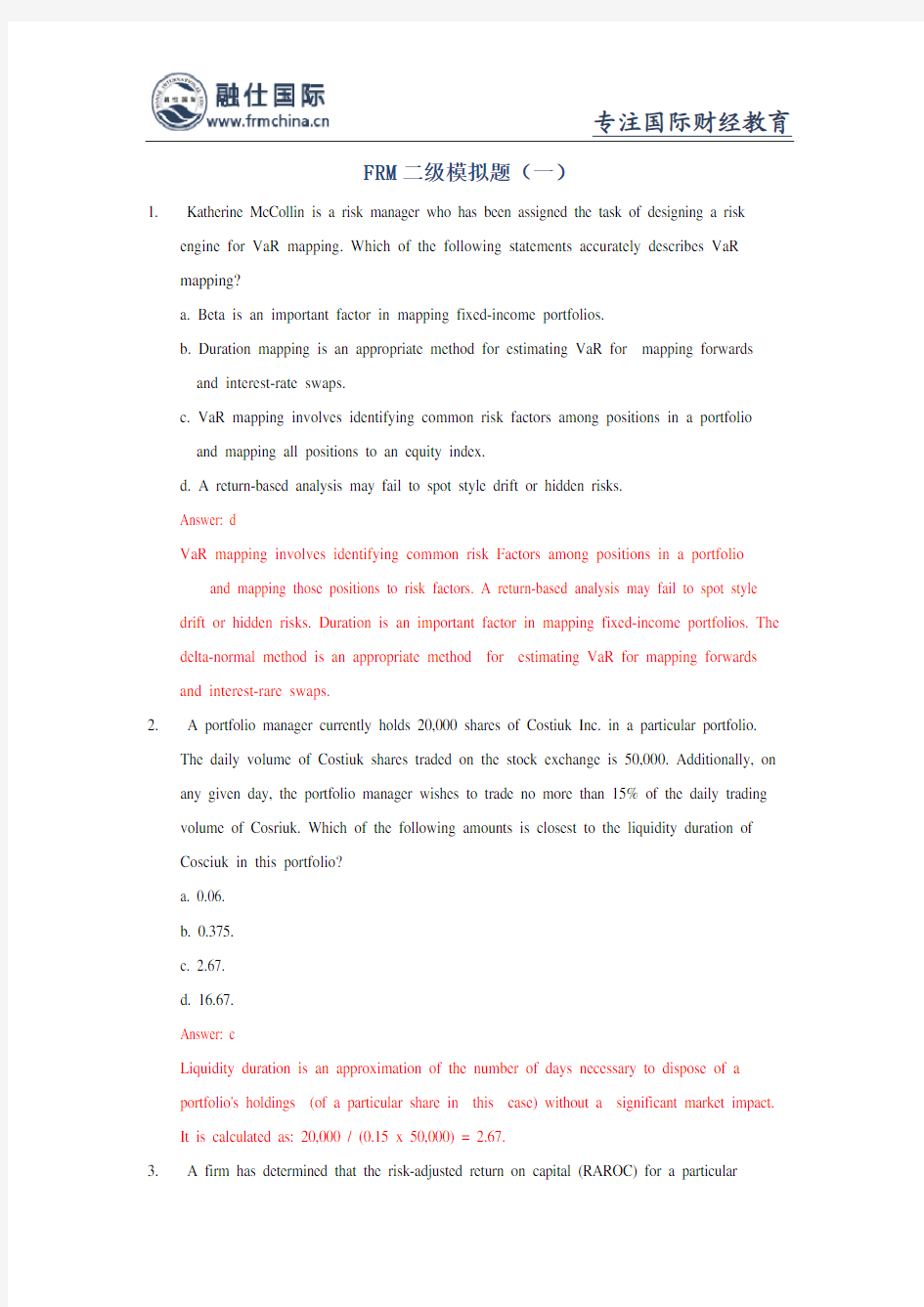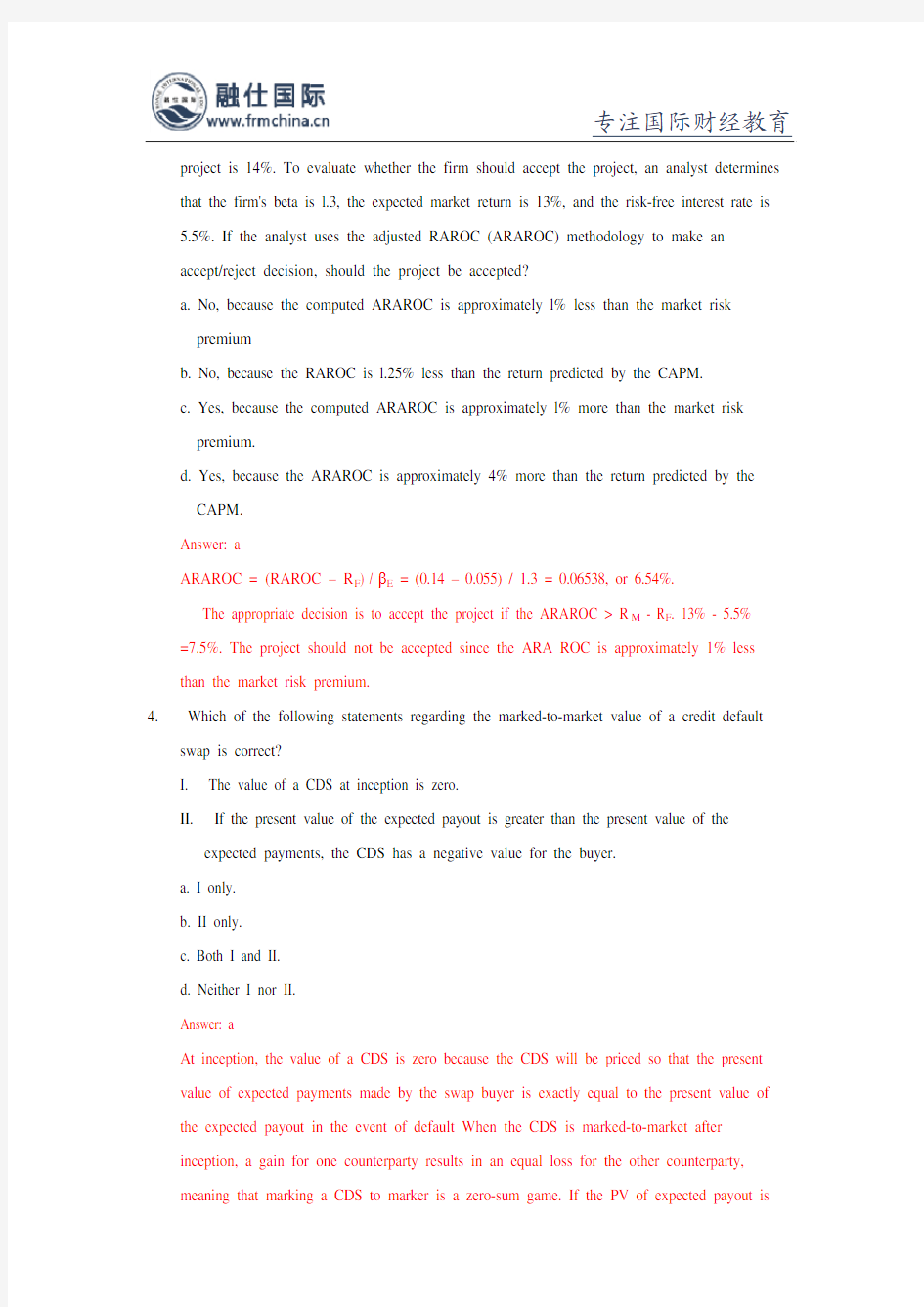FRM二级模拟题(一)


FRM二级模拟题(一)
1. Katherine McCollin is a risk manager who has been assigned the task of designing a risk
engine for VaR mapping. Which of the following statements accurately describes VaR
mapping?
a. Beta is an important factor in mapping fixed-income portfolios.
b. Duration mapping is an appropriate method for estimating VaR for mapping forwards
and interest-rate swaps.
c. VaR mapping involves identifying common risk factors among positions in a portfolio
and mapping all positions to an equity index.
d. A return-based analysis may fail to spot style drift or hidden risks.
Answer: d
VaR mapping involves identifying common risk Factors among positions in a portfolio
and mapping those positions to risk factors. A return-based analysis may fail to spot style drift or hidden risks. Duration is an important factor in mapping fixed-income portfolios. The delta-normal method is an appropriate method for estimating VaR for mapping forwards and interest-rare swaps.
2. A portfolio manager currently holds 20,000 shares of Costiuk Inc. in a particular portfolio.
The daily volume of Costiuk shares traded on the stock exchange is 50,000. Additionally, on any given day, the portfolio manager wishes to trade no more than 15% of the daily trading volume of Cosriuk. Which of the following amounts is closest to the liquidity duration of Cosciuk in this portfolio?
a. 0.06.
b. 0.375.
c. 2.67.
d. 16.67.
Answer: c
Liquidity duration is an approximation of the number of days necessary to dispose of a
portfolio's holdings (of a particular share in this case) without a significant market impact.
It is calculated as: 20,000 / (0.15 x 50,000) = 2.67.
3. A firm has determined that the risk-adjusted return on capital (RAROC) for a particular
project is 14%. To evaluate whether the firm should accept the project, an analyst determines that the firm's beta is l.3, the expected market return is 13%, and the risk-free interest rate is
5.5%. If the analyst uses the adjusted RAROC (ARAROC) methodology to make an
accept/reject decision, should the project be accepted?
a. No, because the computed ARAROC is approximately l% less than the market risk
premium
b. No, because the RAROC is l.25% less than the return predicted by the CAPM.
c. Yes, because the computed ARAROC is approximately l% more than the market risk
premium.
d. Yes, because the ARAROC is approximately 4% more than the return predicted by the
CAPM.
Answer: a
ARAROC = (RAROC – R F) / βE = (0.14 – 0.055) / 1.3 = 0.06538, or 6.54%.
The appropriate decision is to accept the project if the ARAROC > R M - R F. 13% - 5.5% =7.5%. The project should not be accepted since the ARA ROC is approximately 1% less than the market risk premium.
4. Which of the following statements regarding the marked-to-market value of a credit default
swap is correct?
I. The value of a CDS at inception is zero.
II. If the present value of the expected payout is greater than the present value of the expected payments, the CDS has a negative value for the buyer.
a. I only.
b. II only.
c. Both I and II.
d. Neither I nor II.
Answer: a
At inception, the value of a CDS is zero because the CDS will be priced so that the present value of expected payments made by the swap buyer is exactly equal to the present value of the expected payout in the event of default When the CDS is marked-to-market after
inception, a gain for one counterparty results in an equal loss for the other counterparty,
meaning that marking a CDS to marker is a zero-sum game. If the PV of expected payout is
greater than the PV of the expected payments made, the CDS will have a positive value for the buyer since the buyer receives the larger expected payout. If the PV of the expected
payout is less than the PV of the expected payments, the CDS has a positive value for the seller because the seller receives the expected payments.
5. The Basel regulatory framework uses a "building block" approach, whereby a bank's
regulatory capital requirement is the sum of the capital requirements for various risk
categories. Among the risk categories relevant for the banking book and trading book within
a financial institution, which of the following risks would be contained within Pillar I on the
trading book side?
a. Interest rate risk.
b. Business risk.
c. Concentration risk.
d. Liquidity risk.
Answer: a
Pillar l, on the trading book side, contains counterparty credit risk, interest rate risk, equity risk, foreign exchange risk, commodity risk, and operational risk.
